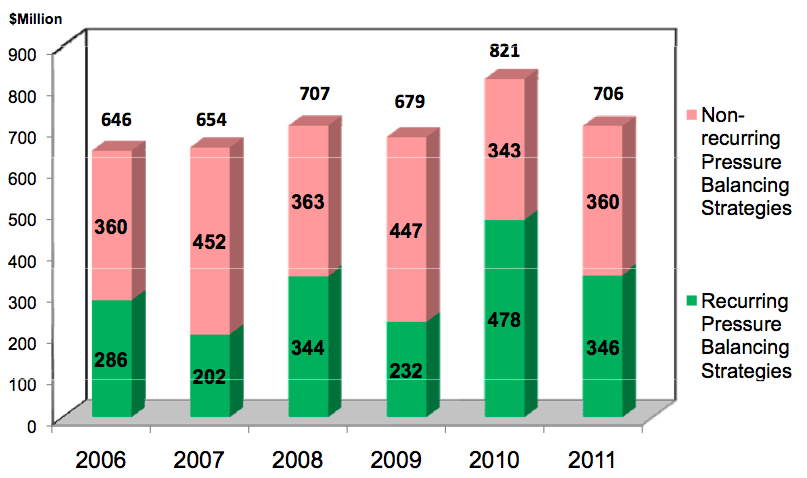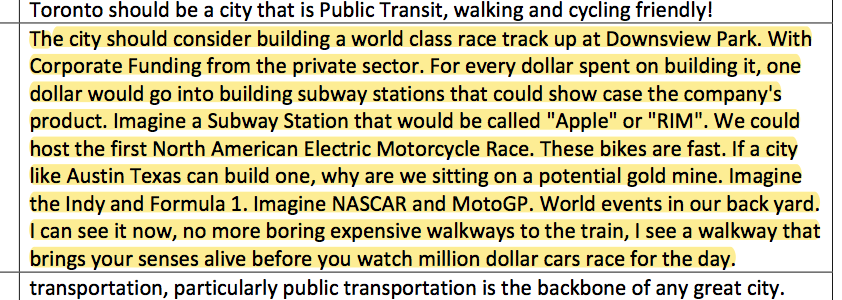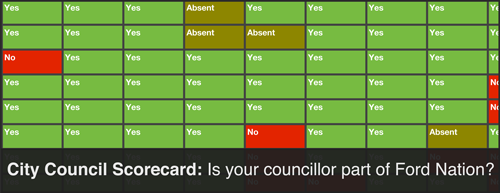There are 194 budget considerations — not recommendations — in the KPMG Core Service Review reports, commissioned by Council to help us fix our budget shortfall. A shortfall that, we’re told again and again, totals $774 million this year. Though it’s impossible to get an accurate estimate of how much would be saved if all of KPMG’s considerations were taken and implemented, some shoddy-guesswork-mixed-with-math puts the total at more than $2 billion.
So, problem solved, right?
That figure really is nonsense, of course. In fact, any attempt to put a dollar value on these budget considerations will inevitably be complete nonsense. Because KPMG lists “detailed articulation of cost savings” as out of scope. They weren’t hired to tell us how much money we could save. Instead, all they’ve done is taken a stab at guessing whether each of their considerations will yield small (5% or less), medium (20% or less) or large (more than 20%) reductions in overall department budgets.
But I don’t want to dismiss the study process outright. KPMG’s work would actually have value if it was presented as only a first step in a long line of studies and planning that will, over many years, yield efficiencies in government. Looking at it like that, this is good data. But, unfortunately, we’re supposed to believe that these documents will serve as the shining star that leads all of us through the 2012 budget crisis and into the promised land.
So let’s look at 2012 — and only 2012 –, because that’s what the mayor seems to be doing. Let’s throw out the 109 KPMG budget considerations that won’t produce savings in the 2012 fiscal year, and instead focus only on the remaining 85 that could possibly produce results within the next year. Of those, only about a dozen look like they could yield savings amounting to more than a few million dollars off the gross budget. (On the net budget, once user fees are other revenues are accounted for, the savings are even smaller.)
The small stuff for 2012 — Riverdale Farm and the Centreville Petting Zoo at $1.4m; Heritage Toronto at $900K; Community Enviroment Days at $500K, and so on — Â is important, of course, and may still face the axe of the overzealous administration at City Hall, but it’s not going to amount to much in the face of that $774 million figure we keep hearing about.
So let’s stick with the big stuff. Below are ten of the biggest cuts or “efficiencies” for 2012, as identified for consideration by KPMG.
10. TTC & Other Agencies: Integrate administrative services with the City
This is a good one to start with, because it’s one of the many places where KPMG has actually identified something kind of reasonable. They say there might be duplication of administrative services across the City’s departments and its boards and agencies. Finding a way to share administrative staff might provide a cost savings without impacting services. This is a legit efficiency that’s worth pursuing.
Service Cut or Efficiency? Efficiency.
How much could it save? Just looking at the TTC as an example, KPMG projects up to 5% savings off a gross budget of $264m, which works out to $13.6m in the best case. In actuality, though, given the administrative needs of the TTC — one of the largest transit corporations in the world — and the complexity of integrating things with the City, it’s unlikely you could just flip a switch and see immediate savings at that level.
Will Council go for it? This isn’t an angle that’s gotten much press throughout this process — it’s kind of boring when compared to, for example, selling the zoo — but it may well come up. Administrative, HR, Payroll and other such functions probably could stand to be better integrated and shared. It’s an idea worth considering.
9. Community Development & Recreation: Cut some Recreational Programs
The City offers a variety of recreational programs, including arts programs, summer camps and fitness & wellness programs. They also offer subsidized access — some based on income — to athletic facilities, including pools, rinks and golf courses. Offering these programs costs $68.2 million gross, though when user fees are taken into accounts, the net cost drops to $38.8 million.
KPMG is detailed in their analysis of this item, asking that we consider questions like, “Should taxpayers pay $2 an hour to have a child figure skate or play hockey? How about an adult? Should it provide extra support for children who can’t afford fees? For adults? Can clear targets be set, and used to evaluate programs, supporting those that provide good value, and changing or terminating those that cost more than they are worth?”
Service Cut or Efficiency: Service Cut.
How much could it save? KPMG says it could be a Low-to-Medium savings, putting it somewhere between 5 and 20%. If we work off their high estimate, that’d be about $13 million.
Will Council go for it? The Ford administration cut access to recreational programs in the 2011 budget, when they removed free access to community centres in the city’s priority neighbourhoods. Odds are good that we’ll see continued cuts to subsidies through an increase in user fees for these programs. Eliminating some programs outright would also be a way to quickly slash the operating budget.
8. Childcare: Reduce funding & subsidies
The goal here would be to reduce the childcare spaces that are funded 100% by the City. Most of the cost behind childcare spaces in Toronto are shared at an 80/20 split with the Provincial and Municipal Governments. But there are some 2,000 such spaces this year — with another 700 set to be added next year — that the province doesn’t provide funding for. These spaces, and maybe even others, could be eliminated.
Keep in mind that there are almost 20,000 children on the waiting list for subsidized childcare in Toronto.
Service Cut or Efficiency? Service Cut. Anything that means a net reduction in the number of childcare spaces has to be considered a service cut.
How much could it save? KPMG pegs this as a ‘Medium’ cost-saver. Childcare costs the City $78 million on its gross budget, but a lot of that is balanced by provincial funding, with the net cost coming out to only $11 million.
Will City Council go for it? I don’t think a reduction in the number of childcare spaces is workable. Even the most cold-hearted councillor will have balk at putting “eliminated spaces for children” on their political résumé. Still, though, the mayor has appointed Councillor Giorgio Mammoliti to head up a task force on childcare in the City, which means we’ll probably get some kind of ridiculous suggestion on this file as part of the overall 2012 budget discussion.
7. Library: Reduce hours & days of operation
KPMG points out that the Toronto Public Library has the highest number of library holdings per capita of all the comparable municipalities they looked at, along with a “high rate of library use.” Our cost-per-library-use is only slightly above the median figure, despite much higher usage.
If this sounds like an efficient service that probably doesn’t need to be cut, too bad. Cuts to library service hours is an easy cost-saver that doesn’t require a lot of administrative upheaval. Even David Miller once tried to close some libraries on Sunday as a cost-saving gambit.
Service Cut or Efficiency: By definition, less hours of operation means less service. A Service Cut.
How much could it save? TPL’s budget for collection use is $87 million gross, which levels out to $78 million net when you account for revenues from late fees, etc. KPMG identifies reduction in service hours as a low-to-medium savings, which pegs it around $17 million at the extreme high end.
Will Council go for it? Cuts to libraries are politically challenging, but we could see a scenario similar to last year’s closing of the Urban Affairs library, where suburban councillors argued that the downtown facility was redundant given its proximity to other branches. No one wants to vote to close or reduce hours at branches in their own ward, but targeting branches in places that are decidedly not part of ‘Ford Nation’ is a possibility. If councillors can deal with the public outcry and the hurdles posed by the existing collective agreement, library cuts are surely on the table for next year.
6. Toronto Fire: Reduce the number of calls
The National Post’s Megan O’Toole has a very well-done look at the ongoing turf war between Fire Services and EMS in this city, which explains the issue better than I ever could. But, in short: the number of fires is down, yet Fire Services is often sent out on calls that they are not fully equipped to deal with. They often then just have to wait until EMS arrives. Changing the system such that Fire doesn’t so often show up at medical calls could result in efficiencies and cost savings.
Service Cut or Efficiency? As long as overall response time doesn’t take a hit, this would be an Efficiency.
How much could it save? KPMG says it’d be a small savings (5%) off the Fire Department’s very large operating budget of $335 million. Though I have to wonder if some or all of the projected savings would be offset by a necessary increase in funding for EMS. (KPMG also has floated the idea of merging EMS and Fire Services, but that couldn’t happen until 2014.)
Will Council go for it? Maybe, but it’s a delicate operation. No councillor wants to open the door to the bad press storm that would arise should a serious incident happen shortly after they’ve voted to make a cut to Emergency Services. Merging EMS and Fire in 2014 probably has a better chance of happening, if the political will is there.
5. Toronto Zoo: Get other levels of government to help
This one’s easy. KPMG says the City could off-load some of its costs for managing the zoo to other levels of government. But we all know that other levels of government are unlikely to go for it, so this isn’t going to happen.
Selling the zoo, something the mayor brought up in his infamous CP24 interview last week, is a move that KPMG says probably could not happen until 2014.
Service Cut or Efficiency? If they could get a government to provide funding that would maintain service levels, this would be an Efficiency.
How much could it save? If another government were to pick up, say, half of the Zoo’s operating budget, that would take $23 million off the city’s gross operating budget. Though when you consider that the Zoo only requires a $12 million subsidy when revenues are factored in, the numbers start to look substantially smaller.
Will Council go for it? They would, sure, but other levels of government are unlikely to come running.
4. TTC: Reduce or eliminate service
TTC ridership is at an all-time-high following the Ridership Growth Strategy introduced in 2003. Therefore, I guess, it’s as good a time as any to cut back on service. Cuts to bus service in 2012 would likely come paired with a fare increase for a double whammy of suck.
Service Cut or Efficiency? Service Cut.
How much would it save? KPMG pegs reductions in the amount of service as bring in ‘Small’ savings, but even 5% of the TTC’s $573 million budget for operating conventional transit is significant.
Will Council go for it? I’d bet heavily that we’ll see a reduction of TTC service in 2012. The Mayor’s Office showed their hand with their push to eliminate late-night and Sunday service on several bus routes in the 2011 budget. It’s worth noting, however, that they had to sell these service cuts as ‘reallocations’, meant to improve transit service on other routes. Even then, they met with enough resistance that they had to publicly revise their plan.
3. Police Service: Eliminate Paid Duty
This cut would target the practice — widely decried — of posting uniformed police officers at construction sites and special events. Council has already taken some steps to reform the policy, voting unanimously to develop “more effective criteria in delineating the need for paid duty policing in traffic control.”
Service Cut or Efficiency? Efficiency, mostly.
How much could it save? KPMG pegs it as a small saving — 5% or less — off the  Police Service’s $716 million gross operating budget. But when the item was debated at committee earlier this year, it was noted that the direct costs incurred by the city due to this program — from hiring police officers to stand guard at city-funded construction projects — stands at between $5 million and $8 million per year.
Will Council go for it? They seemingly already have, though it remains to be seen what the revised policy will look like.
2. Community Grants: Eliminate the Community Partnership & Investment Program
Rob Ford made direct reference to this $47 million program in his interview with Stephen LeDrew last week, indicating that he is unable to justify grants during a time when the city faces a budget shortfall. He has consistently voted against most of the grants covered by CPIP as a councillor, and continues to do so as mayor.
The program covers a variety of grants, from small amounts of money given to local artists under the Mural Program to funding for major events like Pride and Caribana.
Service Cut or Efficiency? Service Cut.
How much could it save? If the whole program was cut in 2012, it would save $47.4 million.
Will Council go for it? Cutting all grants would be challenging — though Rob Ford would seemingly support such a move, he did not find many allies when he voted against a round of community grants at the July Council meeting — but a significant reduction in the amount of grants given is a real possibility. The economic value of community grants is hard to quantify, but it’s generally acknowledged that they provide an economic benefit several times their cost. KPMG notes that every city they researched as part of this study also operates a community grant program.
1. Police Service: Reduce the number of officers and staff
Not much to explain here, as this is both a simple budget consideration and one that is very unlikely to go anywhere. The Toronto Police Service continues to add officers to its ranks despite a declining crime rate. KPMG points out that Toronto has a low arrests-per-officer ratio, but also notes that other cities — especially American cities — have more officers per capita.
Service Cut or Efficiency? It depends on how reductions in staff are achieved. If various crime rate indicators don’t rise as officers/staff are removed, this would probably be an Efficiency.
How much could it save? There’s a lot at play here, especially because the mayor recently inked a new deal with the Toronto Police Union that guarantees them substantial pay increases. Regardless, the Police Service is the biggest cost by far on Toronto residents’ property tax bill, costing nearly twice as much as the next biggest item, the TTC.
Will Council go for it? Layoffs seem very unlikely but the mayor did show a willingness to — quietly — reduce the number of police officers with his 2011 budget. That budget slowed hiring of new officers to replace those that retire. Still, any chance at achieving significant near-term savings on the police budget seem to have flown out the window when the new collective agreement was signed.
Total savings: not much
Let’s imagine a scenario: a new mayor gets elected in Toronto, swept into office on popular support calling for an era of smart fiscal management at City Hall. He’s said he can run a more efficient city, one that still delivers all the same services but with less bureaucratic bloat.
Due to low fuel costs, a mostly snow-free winter and a combination of various other pieces of good luck mixed with some decent planning on the part of the new mayor’s predecessor, the new council is blessed with a significant surplus going into their first budget. They opt to sock most of that surplus away, instead balancing the 2011 budget with a modest property tax increase — in line with inflation. They do cut the vehicle registration tax to $40-per-year, with an eye toward eliminating it completely when the books are in order.
With the 2011 books balanced and 2012 in decent shape due to the retained surplus and revenues, Council is now able to embark on a three-part Core Service Review aided by a consulting firm. First, they’ll identify which programs are mandatory and which are discretionary. Then, they’ll evaluate the value of all programs: both in terms of efficiency and economic/social benefit. Finally, they’ll detail a list of ways the city could save money, with a focus on savings that won’t significantly affect service levels.
Decent, right? But it didn’t happen. Instead, this administration is forcing us to look at a $774 million hole that they helped dig and telling us that we’ve got to throw libraries, community grants, recreational programs and transit service into the abyss to help fill the gap.
But the truth is there, in the very same reports the Fords and their allies keep telling us to look at: there aren’t enough potential cuts available to significantly reduce the 2012 budget shortfall.





